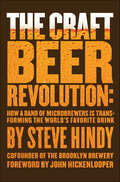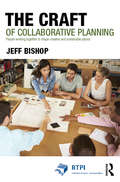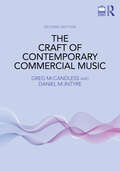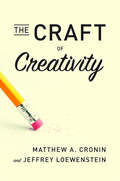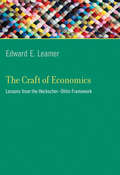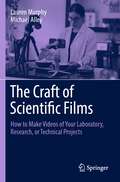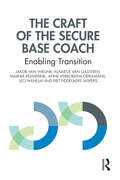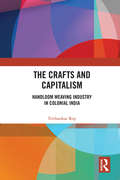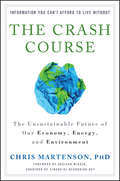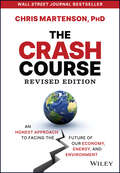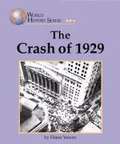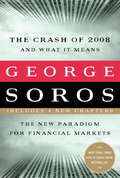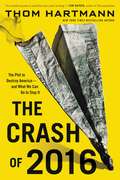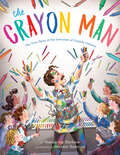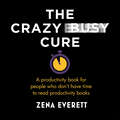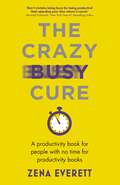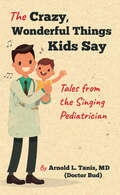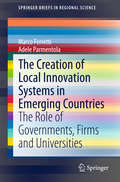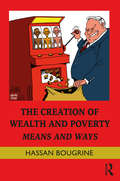- Table View
- List View
The Craft Beer Revolution: How a Band of Microbrewers Is Transforming the World's Favorite Drink
by Steve HindyOver the past 40 years craft-brewed beer has exploded in growth. In 1980, a handful of "microbrewery" pioneers launched a revolution that would challenge the dominance of the national brands, Budweiser, Coors, and Miller, and change the way Americans think about, and drink, beer. Today, there are more than 2,700 craft breweries in the United States and another 1,500 are in the works. Their influence is spreading to Europe's great brewing nations, and to countries all over the globe. In The Craft Beer Revolution, Steve Hindy, co-founder of Brooklyn Brewery, tells the inside story of how a band of homebrewers and microbrewers came together to become one of America's great entrepreneurial triumphs. Beginning with Fritz Maytag, scion of the washing machine company, and Jack McAuliffe, a US Navy submariner who developed a passion for real beer while serving in Scotland, Hindy tells the story of hundreds of creative businesses like Deschutes Brewery, New Belgium, Dogfish Head, and Harpoon. He shows how their individual and collective efforts have combined to grab 10 percent of the dollar share of the US beer market. Hindy also explores how Budweiser, Miller, and Coors, all now owned by international conglomerates, are creating their own craft-style beers, the same way major food companies have acquired or created smaller organic labels to court credibility with a new generation of discerning eaters and drinkers. This is a timely and fascinating look at what America's new generation of entrepreneurs can learn from the intrepid pioneering brewers who are transforming the way Americans enjoy this wonderful, inexpensive, storied beverage: beer.
The Craft of Collaborative Planning: People working together to shape creative and sustainable places (RTPI Library Series)
by Jeff BishopUnlike books that focus solely on methods, The Craft of Collaborative Planning provides a detailed guide to designing and managing all aspects of the collaborative process, advocating for making collaborative work the norm. Beginning with a discussion of the political and legal context of collaborative practice in UK land use planning systems, The Craft of Collaborative Planning tracks a path through the challenging task of process design and working with various groups and individuals. Taking into account the great need for coherent organizational approaches, Bishop outlines evaluation and learning from the collaborative process for the future. Jeff Bishop brings to his writing an exemplary career focused on bringing various parties together to generate creative and widely supported plans and projects. With its focused discussion of UK engagement practices, and detailed outline for making a better collaborative process, The Craft of Collaborative Planning is an essential read for practitioners and decision-makers seeking to bring communities together with creative solutions to spatial planning, design, and development.
The Craft of Contemporary Commercial Music
by Greg McCandless Daniel McIntyreThe role of the commercial composer has grown to include a wide range of new responsibilities. Modern composers not only write music, but often, they also need to record, and market their own works. The Craft of Contemporary Commercial Music prepares today’s music students for their careers by teaching them to compose their own music, produce it professionally, and sell it successfully. The textbook integrates three areas of concentration—music theory and composition, audio engineering, and music business—allowing students to understand and practice how to successfully navigate each stage of a score’s life cycle from concept to contract. Students will learn how to: Translate musical ideas into scores utilizing music theory and composition techniques Transform scores into professional audio through the production stages of tracking, sequencing, editing, mixing, mastering, and bouncing Market works to prospective clients The textbook assumes no prior knowledge of music theory or audio topics, and its modular organization allows instructors to use the book flexibly. Exercises at the end of each chapter provide practice with key skills, and online Instructor and Student Resources support the book with video walkthroughs, streaming audio, a glossary, and printable exercise pages. This second edition includes: Enhanced and new images throughout the book Updated technology examples, including greater integration of Ableton Live Discussions of industry-standard equipment, featuring companies such as Universal Audio, FabFilter, and iZotope More focus on popular music examples throughout the book, particularly in the context of music theory An expanded section on the music business, with new information on contracts, royalties, and digital play-tracking services Exercise answer keys for instructors, new video walkthroughs, and more online resources available at routledgelearning.com/cccm Combining a grounding in music notation and theory concepts with a foundation in essential technologies, The Craft of Contemporary Commercial Music offers an innovative approach that addresses the needs of students preparing for music careers.
The Craft of Creativity
by Matthew A. Cronin Jeffrey LoewensteinCreativity has long been thought of as a personal trait, a gift bestowed on some and unachievable by others. While we laud the products of creativity, the stories behind them are often abridged to the elusive "aha!" moment, the result of a momentary stroke of genius. In The Craft of Creativity Matthew A. Cronin and Jeffrey Loewenstein present a new way to understand how we innovate. They emphasize the importance of the journey and reveal the limitations of focusing on outcomes. Drawing on a wide range of scholarship, their own research, and interviews with professionals and learners who employ creativity in the arts, engineering, business, and more, Cronin and Loewenstein argue that creativity is a cognitive process that hinges on changing one's perspective. It's a skill that anyone can hone, and one that benefits from thinking with others and over time. Breaking new ground in the discussion about how we innovate, this book provides strategies that everyone can use to be more creative.
The Craft of Economics
by Edward E. LeamerIn this spirited and provocative book, Edward Leamer turns an examination of the Heckscher--Ohlin framework for global competition into an opportunity to consider the craft of economics: what economists do, what they should do, and what they shouldn't do. Claiming "a lifetime relationship with Heckscher--Ohlin," Leamer argues that Bertil Ohlin's original idea offered something useful though vague and not necessarily valid; the economists who later translated his ideas into mathematical theorems offered something precise and valid but not necessarily useful. He argues further that the best economists keep formal and informal thinking in balance. An Ohlinesque mostly prose style can let in faulty thinking and fuzzy communication; a mostly math style allows misplaced emphasis and opaque communication. Leamer writes that today's model- and math-driven economics needs more prose and less math. Leamer shows that the Heckscher--Ohlin framework is still useful, and that there is still much work to be done with it. But he issues a caveat about economists: "What we do is not science, it's fiction and journalism. " Economic theory, he writes, is fiction (stories, loosely connected to the facts); data analysis is journalism (facts, loosely connected to the stories). Rather then titling the two sections of his book Theory and Evidence, he calls them Economic Fiction and Econometric Journalism, explaining, "If you find that startling, that's good. I am trying to keep you awake. "
The Craft of Economics: Lessons from the Heckscher-Ohlin Framework (Ohlin Lectures)
by Edward E. LeamerA review of the Heckscher–Ohlin framework prompts a noted economist to consider the methodology of economics.In this spirited and provocative book, Edward Leamer turns an examination of the Heckscher–Ohlin framework for global competition into an opportunity to consider the craft of economics: what economists do, what they should do, and what they shouldn't do. Claiming “a lifetime relationship with Heckscher–Ohlin,” Leamer argues that Bertil Ohlin's original idea offered something useful though vague and not necessarily valid; the economists who later translated his ideas into mathematical theorems offered something precise and valid but not necessarily useful. He argues further that the best economists keep formal and informal thinking in balance. An Ohlinesque mostly prose style can let in faulty thinking and fuzzy communication; a mostly math style allows misplaced emphasis and opaque communication. Leamer writes that today's model- and math-driven economics needs more prose and less math.Leamer shows that the Heckscher–Ohlin framework is still useful, and that there is still much work to be done with it. But he issues a caveat about economists: “What we do is not science, it's fiction and journalism.” Economic theory, he writes, is fiction (stories, loosely connected to the facts); data analysis is journalism (facts, loosely connected to the stories). Rather than titling the two sections of his book Theory and Evidence, he calls them Economic Fiction and Econometric Journalism, explaining, “If you find that startling, that's good. I am trying to keep you awake.”
The Craft of Scientific Films: How to Make Videos of Your Laboratory, Research, or Technical Projects
by Michael Alley Lauren MurphyThis book, the first of its kind, helps scientists and engineers of all stages and disciplines share their work in a new way—with movies. Today, much of scientific communication is embedded in papers and presentations, but these documents don’t often extend outside of a specific academic field. By adding movies as a medium of communication, scientists and engineers can better communicate with their colleagues while also increasing their reach to students, professors, peers, potential collaborators, and the public. Scientific films help translate complex technical topics into more accessible and consumable messages. By following Lauren Murphy’s filmmaking formula – planning, shooting, and editing – readers will create their very own scientific films that look professional and polished. Using tools as simple as a smartphone, readers can develop short, personal stories with no cost or experience needed. This book will guide readers through all steps of the movie making process to a finished product. Readers will evolve their creative thinking skills and use their movies to improve classroom presentations, network across student organizations, present at conferences, recruit students for their labs, secure grant money, and more. Adding a movie to your body of work can be the tool that sparks interest in audiences to learn more—driving traffic to your publications, research projects, and websites. This book will help you develop new skills to become a better communicator while spreading your ideas and research to new audiences.
The Craft of the Secure Base Coach: Enabling Transition
by Jakob van Wielink Leo Wilhelm Riet Fiddelaers-Jaspers Klaartje van Gasteren Marnix Reijmerink Anne Verbokkem-OerlemansWithin The Craft of the Secure Base Coach, the authors take a new and combined approach to the professions of coaching and counselling to provide a guide for professionals wanting to better assist individuals and teams in periods of transition.Based on up-to-date scientific insights, and grounded in concepts from attachment theory, this book explores the themes of life transition based on the authors' own Transition Cycle model, and how professional coaches and counsellors can become a secure base for their clients during sometimes traumatic and transitional periods in their lives. Consisting of two parts, the first part of this book focuses on how to become a secure base coach, using case studies to illustrate how readers can affect real change with their clients when providing humanity and proximity to the professional relationship. The second part provides a more practical guide to working with individuals and groups, and how to apply the themes of the Transition Cycle to help with guiding transition.This will be a valuable resource for coaches, counsellors and therapists, as well as those currently in training. It will also be of use to leaders wishing to learn more about their coaching skills, as well as social workers and grief counsellors/therapists.
The Crafts and Capitalism: Handloom Weaving Industry in Colonial India
by Tirthankar RoyThis book presents a comprehensive history of handloom weaving industry in India to challenge and revise the view that competition from machine-produced textiles destroyed the country’s handicrafts as claimed by historians until recently. It shows that skill-intensive handmade textiles survived the competition on a large scale, and that handmade goods and high-quality manual labour played a positive role in the making of modern India. Rich in archival material, The Crafts and Capitalism explores themes such as the historiography of craft technologies; statistical work on nineteenth-century cotton cloth production trends; narratives of merchants, the social leaders, the factory-owners; tools and techniques; and, shift from handloom to power loom. The book argues that changes in the handloom industry were central to the consolidation of new forms of capitalism in India. An important intervention in Indian economic history, this book will be useful to scholars and researchers of Indian history, economic history, colonial history, modern history, political history, labour history and political economy. It will also interest nongovernmental organizations, textile historians, and design specialists.
The Crash Course
by Chris MartensonThe next twenty years will be completely unlike the last twenty years.The world is in economic crisis, and there are no easy fixes to our predicament. Unsustainable trends in the economy, energy, and the environment have finally caught up with us and are converging on a very narrow window of time--the "Twenty-Teens." The Crash Course presents our predicament and illuminates the path ahead, so you can face the coming disruptions and thrive--without fearing the future or retreating into denial. In this book you will find solid facts and grounded reasoning presented in a calm, positive, non-partisan manner.Our money system places impossible demands upon a finite world. Exponentially rising levels of debt, based on assumptions of future economic growth to fund repayment, will shudder to a halt and then reverse. Unfortunately, our financial system does not operate in reverse. The consequences of massive deleveraging will be severe.Oil is essential for economic growth. The reality of dwindling oil supplies is now internationally recognized, yet virtually no developed nations have a Plan B. The economic risks to individuals, companies, and countries are varied and enormous. Best-case, living standards will drop steadily worldwide. Worst-case, systemic financial crises will toss the world into jarring chaos.This book is written for those who are motivated to learn about the root causes of our predicaments, protect themselves and their families, mitigate risks as much as possible, and control what effects they can. With challenge comes opportunity, and The Crash Course offers a positive vision for how to reshape our lives to be more balanced, resilient, and sustainable.
The Crash Course: An Honest Approach to Facing the Future of Our Economy, Energy, and Environment
by Chris MartensonDiscover how and why the world’s crises are interconnected and what you can do to prepare for the next one The world is experiencing a series of crises. In The Crash Course: An Honest Approach to Facing the Future of Our Economy, Energy, and Environment, Revised Edition, veteran executive and strategist Chris Martenson delivers an incisive and eye-opening exploration that explains why the reader needs to understand that it is the interconnectedness of the various crises that matters most. From energy shortages to climate instability, financial crises, supply chain disruptions, pandemics, war, and crop failures, you’ll discover the common factor that is driving them all and how to adapt to volatile new realities and safeguard your own personal wealth, health, and community. In the book, you’ll find effective solutions for living with unpredictability and change, as well as: A workable framework for understanding the “how” and “why” of dramatic societal, environmental, and economic transformation A rich set of solutions, complete with examples, you can use to draw inspiration and motivation to act in your own life An expansive amount of new material, fully updated since the last editionA transformative and thought-provoking strategic playbook for managing increasingly unexpected events, crises, and revolutions, The Crash Course, Revised Edition is an essential resource for anyone concerned about their retirement savings, the world’s environment, as well as anyone hoping to become more independent and self-reliant.
The Crash of 1929
by Nathan AasengAlmost overnight, the hopes, dreams, and life savings of millions of Americans were wiped out when the stock market crashed in October of 1929, and ushered in the Great Depression. This book tells how the unthinkable happened, and how the crash changed the course of history.
The Crash of 2008 and What it Means: The New Paradigm for Financial Markets
by George SorosIn the midst of one of the most serious financial upheavals since the Great Depression, George Soros, the legendary financier and philanthropist, writes about the origins of the crisis and proposes a set of policies that should be adopted to confront it. Soros, whose breadth of experience in financial markets is unrivaled, places the crisis in the context of his decades of study of how individuals and institutions handle the boom and bust cycles that now dominate global economic activity. In a concise essay that combines practical insight with philosophical depth, Soros makes an invaluable contribution to our understanding of the great credit crisis and its implications for our nation and the world.
The Crash of 2016
by Thom HartmannThe United States is more vulnerable today than ever before-including during the Great Depression and the Civil War-because the pillars of democracy that once supported a booming middle class have been corrupted, and without them, America teeters on the verge of the next Great Crash.The United States is in the midst of an economic implosion that could make the Great Depression look like child's play. In THE CRASH OF 2016, Thom Hartmann argues that the facade of our once-great United States will soon disintegrate to reveal the rotting core where corporate and billionaire power and greed have replaced democratic infrastructure and governance. Our once-enlightened political and economic systems have been manipulated to ensure the success of only a fraction of the population at the expense of the rest of us.The result is a "for the rich, by the rich" scheme leading to policies that only benefit the highest bidders. Hartmann outlines the destructive forces-planted by Lewis Powell in 1971 and come to fruition with the "Reagan Revolution"-that have looted our nation over the past decade, and how their actions fit into a cycle of American history that lets such forces rise to power every four generations.However, a backlash is now palpable against the "economic royalists"-a term coined by FDR to describe those hoarding power and wealth-including the banksters, oligarchs, and politicians who have plunged our nation into economic chaos and social instability.Although we are in the midst of what could become the most catastrophic economic crash in American History, a way forward is emerging, just as it did in the previous great crashes of the 1760s, 1856, and 1929. The choices we make now will redefine American culture. Before us stands a genuine opportunity to embrace the moral motive over the profit motive-and to rebuild the American economic model that once yielded great success.Thoroughly researched and passionately argued, THE CRASH OF 2016 is not just a roadmap to redemption in post-Crash America, but a critical wake-up call, challenging us to act. Only if the right reforms are enacted and the moral choices are made, can we avert disaster and make our nation whole again.
The Crash of Flight 3804: A Lost Spy, a Daughter’s Quest, and the Deadly Politics of the Great Game for Oil
by Charlotte Dennett&“Charlotte Dennett has written an excellent book summarizing the geopolitics of the Middle East historically through to current events. . . . This is an amazing piece of historical writing. . . . Students, foreign affairs &‘experts&’ and officials should have this work as required reading.&”—Jim Miles, Palestine Chronicle&“[Dennett is] an expert in resource-based politics.&”—TimeUnraveling the mystery of a master spy&’s death by following pipelines and mapping wars in the Middle East.In 1947, Daniel Dennett, America&’s sole master spy in the Middle East, was dispatched to Saudi Arabia to study the route of the proposed Trans-Arabian Pipeline. It would be his last assignment. A plane carrying him to Ethiopia went down, killing everyone on board. Today, Dennett is recognized by the CIA as a &“Fallen Star&” and an important figure in US intelligence history. Yet the true cause of his death remains clouded in secrecy.In Follow the Pipelines, investigative journalist Charlotte Dennett digs into her father&’s postwar counterintelligence work, which pitted him against America&’s wartime allies—the British, French, and Russians—in a covert battle for geopolitical and economic influence in the Middle East. Through stories and maps, she reveals how feverish competition among superpower intelligence networks, military, and Big Oil interests have fueled indiscriminate attacks, misguided foreign policy, and targeted killings that continue to this day.The book delivers an irrefutable indictment of these devastating forces and demonstrates how the brutal violence they incite has shaped the Middle East and birthed an era of endless conflict.Follow the Pipelines also brings new questions to the fore:To what lengths has the United States negotiated with the Taliban, Al Qaeda, and ISIS to secure Big Oil&’s holdings in Syria, Iraq, Afghanistan, and Yemen?Was the Pentagon&’s goal of defeating ISIS a fraudulent pretext for America&’s occupation of Syrian eastern provinces and a land grab for oil?Did the infamous double agent Kim Philby, who worked for the British while secretly spying for the Russians, have anything to do with Dennett&’s death?Why have the US and China made North Africa the next major battleground in the Great Game for Oil?Part personal pilgrimage, part deft critique, Dennett&’s insightful reportage examines what happens to international relations when oil wealth hangs in the balance, and she shines a glaring light on what so many have actually been dying for.
The Crayon Man: The True Story of the Invention of Crayola Crayons
by Natascha BiebowCelebrating the inventor of the Crayola crayon! This gloriously illustrated picture book biography tells the inspiring story of Edwin Binney, the inventor of one of the world's most beloved toys. A perfect fit among favorites like The Day the Crayons Quit and Balloons Over Broadway.purple mountains&’ majesty, mauvelous, jungle green, razzmatazz… What child doesn't love to hold a crayon in their hands? But children didn't always have such magical boxes of crayons. Before Edwin Binney set out to change things, children couldn't really even draw in color. Here&’s the true story of an inventor who so loved nature&’s vibrant colors that he found a way to bring the outside world to children – in a bright green box for only a nickel! With experimentation, and a special knack for listening, Edwin Binney and his dynamic team at Crayola created one of the world&’s most enduring, best-loved childhood toys – empowering children to dream in COLOR!
The Crazy Busy Cure *BUSINESS BOOK AWARDS WINNER 2022*: A productivity book for people with no time for productivity books
by Zena Everett**SHORTLISTED FOR THE BUSINESS BOOK AWARDS 2022**"Don't mistake being busy for being productive! Create time to read this important book and start spending your time where it counts." Marshall Goldsmith, New York Times #1 bestselling authorHow we spend our time is one of the greatest indicators of how successful we will be. We achieve our goals when we ruthlessly prioritise tasks and people that are important to us.This audiobook is for you if: · You feel unrelentingly busy and overwhelmed. · 3pm arrives and you've not done any of the tasks you intended. · When you're not working, you're still 'on' - checking emails and always thinking about what you haven't done. · You over-commit and find it hard to say no. · You sacrifice your own priorities for disorganised people's urgent demands. · Meetings, emails, and constant interruptions suck the life out of you. · Your HR department's emails about wellness week are the final straw: meditation won't help your wellbeing, less meetings would.If we focus our time, energy and attention on the wrong things we will never achieve the success or happiness that we aspire to. The problem is that the low value, low impact tasks that distract us from our priorities, are hard to ignore. They scream out at us all day: digital distractions, other people's urgent demand for 'five minutes' that's never five minutes, the meetings that you shouldn't be in, the pointless email chains, the reports you write that don't get read. We get a hit from ticking these tasks off a list. It's got us hooked on crazy busyness. But all we are doing is scratching off a layer of fake work on top of the real, valuable work.The Crazy Busy Cure is full of intensely practical tips to save you from this addiction and get productive again. It will show you how to have a laser focus on your priorities, manage others so they can get on with the work and find more head space. With tips for remote working and office working alike as well as productivity hacks for people with learning and thinking differences, this lively listen is jam packed with solutions.Zena Everett is executive coach and organisational psychologist and draws from her many thousands of hours and coaching and speaking to people about productivity blockers and how to shift them. Stay energised, find your freedom from distractions and regain your productivity.(P) 2021 Hodder & Stoughton Limited
The Crazy Busy Cure: A productivity book for people with no time for productivity books
by Zena Everett"Don't mistake being busy for being productive! Create time to read this important book and start spending your time where it counts." Marshall Goldsmith, New York Times #1 bestselling authorHow we spend our time is one of the greatest indicators of how successful we will be. We achieve our goals when we ruthlessly prioritise tasks and people that are important to us.This book is for you if: · You feel unrelentingly busy and overwhelmed. · 3pm arrives and you've not done any of the tasks you intended. · When you're not working, you're still 'on' - checking emails and always thinking about what you haven't done. · You over-commit and find it hard to say no. · You sacrifice your own priorities for disorganised people's urgent demands. · Meetings, emails, and constant interruptions suck the life out of you. · Your HR department's emails about wellness week are the final straw: meditation won't help your wellbeing, less meetings would.If we focus our time, energy and attention on the wrong things we will never achieve the success or happiness that we aspire to. The problem is that the low value, low impact tasks that distract us from our priorities, are hard to ignore. They scream out at us all day: digital distractions, other people's urgent demand for 'five minutes' that's never five minutes, the meetings that you shouldn't be in, the pointless email chains, the reports you write that don't get read. We get a hit from ticking these tasks off a list. It's got us hooked on crazy busyness. But all we are doing is scratching off a layer of fake work on top of the real, valuable work.The Crazy Busy Cure is full of intensely practical tips to save you from this addiction and get productive again. It will show you how to have a laser focus on your priorities, manage others so they can get on with the work and find more head space. With tips for remote working and office working alike as well as productivity hacks for people with learning and thinking differences, this lively read is jam packed with solutions.Zena Everett is executive coach and organisational psychologist and draws from her many thousands of hours and coaching and speaking to people about productivity blockers and how to shift them. Stay energised, find your freedom from distractions and regain your productivity.
The Crazy, Wonderful Things Kids Say: Tales from the Singing Pediatrician
by Arnold L. TanisA pediatrician shares accounts of the humorous and heartwarming things his young patients have said to him over the course of his career.“Hey, doctor, I want to tell you something!”For fifty-four years, kids have shared with pediatrician Arnold Tanis stories, questions, and bold pronouncements about their childhood worlds. In between treating them, the good doctor wrote down what many of them said. Three generations of patients offer memorable and downright funny observations and opinions about all sorts of things: shots, school, their brothers and sisters, growing up, and even Dr. Tanis himself and whether he can sing as well as he thinks he does. The parents also chime in, both to complain about all their kids put them through and to celebrate how well they eventually turn out.A tireless, lifelong advocate of child safety, Dr. Tanis’s impact on his patients and their families spans decades. This book is a testament to his career and a memorable glimpse of the warm and sometimes crazy world of a singing pediatrician.
The Creating Mind: Harnessing Its Power for Success
by Howard GardnerAs this chapter illustrates, the creative mind is highly sought after in our innovation-driven economy. The creator stands out in terms of temperament, personality, and stance.
The Creation and Destruction of Value: The Globalization Cycle
by Harold JamesHarold James examines the vulnerability and fragility of processes of globalization, both historically and in the present. This book applies lessons from past breakdowns of globalization—above all in the Great Depression—to show how financial crises provoke backlashes against global integration: against the mobility of capital or goods, but also against flows of migration. By a parallel examination of the financial panics of 1929 and 1931 as well as that of 2008, he shows how banking and monetary collapses suddenly and radically alter the rules of engagement for every other type of economic activity. Increased calls for state action in countercyclical fiscal policy bring demands for trade protection. In the open economy of the twenty-first century, such calls are only viable in very large states—probably only in the United States and China. By contrast, in smaller countries demand trickles out of the national container, creating jobs in other countries. The international community is thus paralyzed, and international institutions are challenged by conflicts of interest. The book shows the looming psychological and material consequences of an interconnected world for people and the institutions they create.
The Creation of Local Innovation Systems in Emerging Countries
by Marco Ferretti Adele ParmentolaThis book deals with the creation of local innovation systems (LIS) in emerging countries. The authors analyze the role of the government, firms and research centers in the formation of LIS. Special attention is paid to the manner in which different leading actors implement their LIS development strategies. The book presents detailed case studies on different strategies used to implement LIS in Singapore, Dubai, Taiwan and Iran.
The Creation of Wealth and Poverty: Means and Ways (Routledge Frontiers of Political Economy)
by Hassan BougrineThe Creation of Wealth and Poverty is a study of the means and ways by which wealth and poverty are created in both developed and developing countries. It puts a particular emphasis on the role played by economic policy in shaping the stratification of modern societies through specific programmes dealing with issues of job creation, poverty and environmental degradation. This book is concerned with the social effects of the ongoing crisis in finance, development and the environment. By focusing on the political, legal and financial institutions that govern society and the economy, the book provides an analysis of wealth and poverty from a historical perspective. It shows how economic and social policies of the neoliberal model have led to a rise in unemployment, poverty and inequality and, therefore, made societies more polarized. This volume will be of great interest to policymakers, academics and students who study political economy, development economics and macroeconomics.
The Creation of the East Timorese Economy: Volume 1: History of a Colony (Palgrave Studies in Economic History)
by Mats Lundahl Fredrik SjöholmThis two-volume study explores the economy of East Timor, of which very little has been written since the country gained independence in 2002. Currently, no comprehensive account exists of the economic history of the country. The former cannot be properly understood without a knowledge of the historical process that created the present-day situation. This research monograph is the first book to combine a historical analysis of the creation and development of the economy of East Timor from the earliest times to the present, and an analysis of the main contemporary problems facing the East Timorese economy. Volume I considers East Timor from a chronological perspective, as an occupied country up to the point at which Indonesia leave.This book will appeal to scholars and students of economics, political and social science. It will also be of interest to practitioners in these fields as it focuses on down-to-earth problems that need to be solved for the economy to develop.
The Creation of the East Timorese Economy: Volume 2: Birth of a Nation (Palgrave Studies in Economic History)
by Mats Lundahl Fredrik SjöholmVery little has been written on the economy of East Timor since the country’s independence in 2002, and no comprehensive account exists of the economic history of the country. The former cannot be properly understood without a knowledge of the historical process that created the present-day situation. This research monograph is the first book to combine a historical analysis of the creation and development of the economy of East Timor from the earliest times to the present, and an analysis of the main contemporary problems facing the East Timorese economy. Volume II offers a detailed analysis of the economy of East Timor, of politics, fiscal policy and social progress. It pays particular attention to structural problems: employment generation and the lack of a modern sector, the modernization of agriculture and the management of the oil deposits in the Timor Sea. The first volume, available separately, considers East Timor from a chronological perspective, as a Portuguese colony, and a country occupied by Indonesia up to national independence in 2002. This book will appeal to economists, political scientists and social scientists in general as well as practitioners, since it focuses on down-to-earth problems that need to be solved for the economy to develop. The book can also be read by students both at the undergraduate and graduate levels and could be used for case studies in development.
